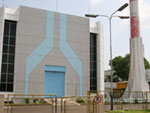MENU

|
| FNCA 2000 Workshop on Nuclear Safety Culture |
 Summary Summary
| 1) Date : |
September 4-7, 2000 |
| 2) Place : |
Shanghai, China |
| 3) Sponsored by : |
Australian Nuclear Science and Technology Organisation (ANSTO)
China Atomic Energy Authority (CAEA) |
| 4) In Cooperation with : |
Japan Atomic Industrial Forum, Inc. (JAIF) |
| 5) Attendance : |
25 participants from Australia (3), China (8), Indonesia
(2), Japan (7),
Korea (1), Malaysia (1), The Philippines (1), Thailand (1), Viet Nam (1) |
 Reports
and Discussions Reports
and Discussions
1)The Main Topics of the Workshop
| |
a) |
Reporting against the 6 safety culture activity indicators |
| |
b) |
Reporting against IAEA Safety Report Series No.11 |
| |
c) |
Reporting against the Nuclear Safety Convention Articles 7-10 |
| |
d) |
Working groups on warning signs of a declining safety culture |
| |
e) |
Safety culture attitudial surveys |
| |
f) |
Safety culture in nuclear power plants (China and Japan) |
| |
g) |
Lessons learned from the JCO criticality accident in Tokai
and the source accident in Thailand |
| |
h) |
Visit to Qinshan Nuclear Power Plant |
| |
i) |
Discussion on future activities |
2) Outcomes
| |
a) |
The workshop noted the progress in safety culture implementation
and development of new initiatives from the previous
workshop. It recognized the contribution made through
a continuity of representations in achieving this progress. |
| |
b) |
The progress in implementation of safety culture varied
among countries and the workshop agreed to develop 11
benchmarks for assessing the level of implementation.
(See below.) |
| |
c) |
Those countries that had not yet done so were encouraged
to report against the indicators for a typical research
reactor. |
| |
d) |
The workshop noted that a number of countries had particular
problems due to lack of resources to regulate users of
radioactive materials and some requested assistance with
developing regulations for their nuclear activities.
The workshop recommended that the FNCA Coordinators should
address these issues in their future meetings. |
| |
e) |
The workshop recommended that all FNCA countries should
assess their research reactors against the Nuclear Safety
Convention Articles. For the next workshop, the participants
agreed that the reporting should be extended to article
14 (Assessment and Verification of Safety) and article
16 (Emergency Preparedness) but that any updates on articles
7-10 should also be reported. |
| |
f) |
The workshop received valuable reports on safety culture
implementation programs in Qinshan NPP and Hamaoka NPP.
The participants considered that these experiences from
the NPPs were very useful in highlighting key features
of successful safety culture implementation. |
| |
g) |
The workshop discussed the lessons to be learned from
the JCO criticality accident and the source accident
in Thailand. These accidents emphasised the need for
continued attention to safety culture, especially the
need for active and effective regulatory systems and
thorough training of users of radioactive materials. |
3) Future Activities
| |
a) |
The participants agreed to exchange information on training
courses on safety culture at the next workshop. |
| |
b) |
Japan and Australia undertook to look into how the exchange
of information via a web page and other reporting mechanisms could
best be achieved. |
| |
c) |
The next workshop should be held in Japan to allow visits by
delegates to nuclear facilities having safety culture programs. |
 11 Benchmarks for Assessing the Level of Safety Culture
Implementation 11 Benchmarks for Assessing the Level of Safety Culture
Implementation
| |
1. |
Top level policy statement outlining commitment to safety culture
and giving top priority to safety. Adopted by all facilities. |
| |
2. |
There is an active nuclear safety review committee that reports
its findings at corporate level. |
| |
3. |
Formal meetings of the top management board (or equivalent)
include agenda items on safety. |
| |
4. |
Effectively independent and active regulatory organization that
establishes standards and regulations. |
| |
5. |
Safety assessment process for all activities with approvals
reviewed on an annual basis. |
| |
6. |
Mechanism to promote safety culture in the organization - e.g.
task group or committee. |
| |
7. |
A system of regular reporting against safety performance and
safety culture indicators with a program for the improvement of
performance. |
| |
8. |
System for allowing feedback from employees on nuclear safety. |
| |
9. |
The assignment of safety responsibilities at all levels of the
organization has been clearly enunciated, through for example,
a delegation document, or set of duty statements. |
| |
10. |
Regular training courses on safety culture for all nuclear facilities
employees. |
| |
11. |
Accidents/incidents investigation process, conducted independently
of operating group and involving assessment of organizational
and human factors. |
|
|
page top↑ |